The Ultimate Guide to Growing Long Healthy Hair
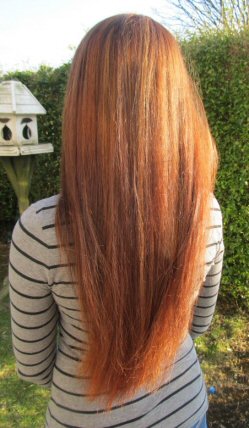 Have you always wanted long, flowing tresses? Do you find it difficult to
grow your hair past a certain length? Have no fear! In this article, all the
information you could possibly need is provided to help you grow the hair of
your dreams. Constantly portrayed as being sexy, young and stylish by the media
- long hair is the envy of many people. Huge amounts of money are spent each
year maintaining false hair extensions, which often need to be replaced after a
few months of wear. If you're tired of paying for something you could have
naturally with a little TLC, read up! I started growing my hair around 2 years
ago using all of these tips from shoulder length - it is now down to my waist. Have you always wanted long, flowing tresses? Do you find it difficult to
grow your hair past a certain length? Have no fear! In this article, all the
information you could possibly need is provided to help you grow the hair of
your dreams. Constantly portrayed as being sexy, young and stylish by the media
- long hair is the envy of many people. Huge amounts of money are spent each
year maintaining false hair extensions, which often need to be replaced after a
few months of wear. If you're tired of paying for something you could have
naturally with a little TLC, read up! I started growing my hair around 2 years
ago using all of these tips from shoulder length - it is now down to my waist.
Step 1: Assess the Damage
After x amount of years of harsh products, heat damage, chemical build up or
colorants - hair becomes damaged. Not everybody knows how to tell if their hair
is actually damaged or not. Typical characteristics of damaged hair are dryness,
frizz and excessive breakage. To determine if the amount of breakage you
experience is abnormal - place a white piece of paper on your lap before
brushing your hair above it. You will likely see lots of small strands of hair,
each around an inch long. They are generally from the ends of the hair, and
break off during brushing or styling. A certain amount of breakage is normal,
but for some people this occurs so much that it hinders hair growth. (This isn't
strictly true, but its effects are the same ). A normal amount of breakage would
be around 20 - 40 bits of hair depending on thickness and other factors. If you
are seeing amounts much larger than this, your hair is definitely in need of a
trim!
Step 2: Starting with a Clean Slate
In order to grow long hair, seriously damaged hair needs to be removed to see
any progress. It is a fact that isn't welcome news for most, it was hard for me
too. My hair was down to my bra strap, and had been this length for years. I
couldn't understand why it wasn't growing. This is a common misconception – hair
that stays the same length for a very long time is too damaged to gain length.
The hair is growing, but the ends are breaking off at such an alarming rate that
no growth can be retained! Many people stubbornly leave their hair for years,
insisting that it simply 'doesn't grow'. In actual fact, a trim is necessary to
remove the damage. For me, this meant cutting hair that was down to my bra strap
up to shoulder length. I was upset, it seemed like a backwards step towards
achieving my goal. It is a necessary evil – just be sure to remind yourself that
you are doing this to have lustrous long locks in the future. Your future self
will thank you. You may not have to cut off much, only what is unsalvageable. If
your hair hasn't 'grown' for years, a few inches at least will be sufficient.
Step 3: Change Your Styling Habits
Ok, so the damaged hair has been removed. In order to preserve the health of
your hair and its new growth, styling habits must be assessed (and changed) if
necessary. The main culprit here is heat. Curlers, tongs, flat irons, blow
dryers – they all contribute to hair dryness and breakage. I went from blow
drying and flat ironing my hair everyday to just drying it naturally – nothing
else! If your hair is used to frequent heat, it may take time for your tresses
to adjust. At first, my naturally dried hair was a frizzy mess. Patience is
required to 'train' your hair into looking presentable naturally. There is
simply no way around it, if you want to grow hair that is long and healthy
certain things must be sacrificed. Now, there are products on the market that
claim to protect your hair against heat damage. This is true (to a small
extent). These products create a thin usually silicone based layer over your
hair in between it and the heat source, preventing damage on a very small scale.
Generally, these kinds of products are for the most part ineffective. There are
many alternatives to heat styling that can give you a similar result. A quick
internet search of techniques such as 'heatless styling', 'foam rollers', 'hair
wrapping' or 'pin curls' can provide many suggestions. As well as heat, lots of
mechanical damage can occur through brushing or combing. Many people are unaware
of the kind of brush that is suitable for their hair type, and are much too
rough. Using a wide tooth comb instead of a traditional bristle brush is
recommended for all hair types, especially for those with curls. Using this will
reduce breakage and retain more length. Another mistake many people make when
trying to grow their hair is brushing it when it is wet – don't ever do this!
When wet, hair is much more elastic and therefore prone to breakage. To maintain
the health of freshly trimmed hair, ensure that hair is only de-tangled when dry
and with a wide tooth comb. Besides heat, the other big no-no is chemical hair
dye. Now, I seem like quite a hypocrite here, since in the photograph provided I
clearly have dyed hair! When you have reached your desired length and don't want
to grow much longer, this is fine to do (within reason). You can't over process
your hair and expect little damage. During the process of growing your hair it
may hinder length retention. When I was growing mine, I completely stopped dying
it. Henna is a fantastic alternative to chemical hair dye, and is actually great
for your hair! Many users report that thickness and shine increases after henna
usage. As well as this, it provides a beautiful spectrum of permanent color.
Step 4: Review the Products You Use to Maintain Hair Health
Shampoo
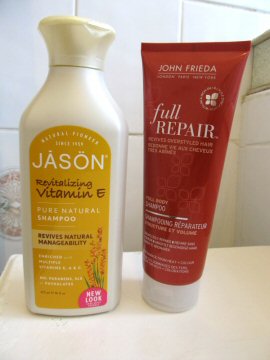 In order to grow hair that is long and strong, the correct products need to
be used to maintain its health. Many people are using products that are not
appropriate for their hair type. Most shampoos and conditioners found at
drugstores contain harsh chemicals such as sodium lauryl sulphate or sodium
laureth sulphate. These chemicals are mostly found in shampoos and are used to
create the luxurious lather we are all used to when washing our hair. They break
down oils and sebum, leaving hair squeaky clean. All of the hairs natural
protective oils are stripped, which means that for most people conditioner is
necessary. There is much debate on the 'safety' of sodium lauryl sulphate and
its cousins – with some reports suggesting that it may be carcinogenic. A wealth
of information on this topic is available online, if you wish to research
further. Many reports are contradictory and the majority of people use SLS with
no ill effects. Using a shampoo that is sulphate free can help heal dry hair and
alleviate flaky scalp problems. I have included some photographs of personally
tried and tested brands for this (an example of each), but products work
differently for everyone. In order to grow hair that is long and strong, the correct products need to
be used to maintain its health. Many people are using products that are not
appropriate for their hair type. Most shampoos and conditioners found at
drugstores contain harsh chemicals such as sodium lauryl sulphate or sodium
laureth sulphate. These chemicals are mostly found in shampoos and are used to
create the luxurious lather we are all used to when washing our hair. They break
down oils and sebum, leaving hair squeaky clean. All of the hairs natural
protective oils are stripped, which means that for most people conditioner is
necessary. There is much debate on the 'safety' of sodium lauryl sulphate and
its cousins – with some reports suggesting that it may be carcinogenic. A wealth
of information on this topic is available online, if you wish to research
further. Many reports are contradictory and the majority of people use SLS with
no ill effects. Using a shampoo that is sulphate free can help heal dry hair and
alleviate flaky scalp problems. I have included some photographs of personally
tried and tested brands for this (an example of each), but products work
differently for everyone.
Conditioner
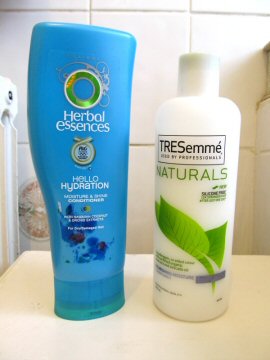 As well as this, most products contain silicones – particularly conditioners.
Silicones are used to cover the hair in a protective 'film', making the hair
silky to the touch and shiny. The most commonly used is dimethicone. Some other
examples include amodimethicone, cyclomethicone and cyclopentasiloxane. These
kinds of silicones are not water soluble, and therefore leave a residue on the
hair. The only thing that can remove these chemicals are sulphates, just
mentioned above. For some people this chemical is fantastic for hair
conditioning, while for others it builds up extremely quickly – leaving the hair
dry and brittle. If you decide to use a sulphate free shampoo, using a
conditioner that has water soluble silicones or is silicone free is a good idea
to prevent build-up. Dimethicone copolyl and lauryl methicone copolyol are both
examples of water soluble silicones. I have included a photo of two conditioners
that I consider to be excellent, one that is silicone based and one that isn't. As well as this, most products contain silicones – particularly conditioners.
Silicones are used to cover the hair in a protective 'film', making the hair
silky to the touch and shiny. The most commonly used is dimethicone. Some other
examples include amodimethicone, cyclomethicone and cyclopentasiloxane. These
kinds of silicones are not water soluble, and therefore leave a residue on the
hair. The only thing that can remove these chemicals are sulphates, just
mentioned above. For some people this chemical is fantastic for hair
conditioning, while for others it builds up extremely quickly – leaving the hair
dry and brittle. If you decide to use a sulphate free shampoo, using a
conditioner that has water soluble silicones or is silicone free is a good idea
to prevent build-up. Dimethicone copolyl and lauryl methicone copolyol are both
examples of water soluble silicones. I have included a photo of two conditioners
that I consider to be excellent, one that is silicone based and one that isn't.
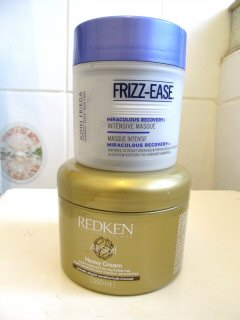 Ultimately, it is completely up to you whether you want to use sulphate
shampoo or non sulphate, silicone conditioners or non silicone – etc. Each
persons hair responds in different ways, but these are things you must consider
when choosing products to maintain healthy hair. Choosing products that are
right for you also depends on hair type and texture. For example, if you have
dry hair – choose moisturizing products. If you have oily hair, experiment with
cleansing products that leave little residue. If your hair is heat damaged or
treated with chemical dye, a protein based conditioner would be beneficial. Heat
and chemical color break down the chemical protein structure of the hair shaft.
If a hair product is described as being 'reconstructing', it is most likely
protein based. If you are unsure, check for chemicals such as hydrolyzed wheat
protein or keratin on the bottle. I have included a photograph of some protein
based products. Ultimately, it is completely up to you whether you want to use sulphate
shampoo or non sulphate, silicone conditioners or non silicone – etc. Each
persons hair responds in different ways, but these are things you must consider
when choosing products to maintain healthy hair. Choosing products that are
right for you also depends on hair type and texture. For example, if you have
dry hair – choose moisturizing products. If you have oily hair, experiment with
cleansing products that leave little residue. If your hair is heat damaged or
treated with chemical dye, a protein based conditioner would be beneficial. Heat
and chemical color break down the chemical protein structure of the hair shaft.
If a hair product is described as being 'reconstructing', it is most likely
protein based. If you are unsure, check for chemicals such as hydrolyzed wheat
protein or keratin on the bottle. I have included a photograph of some protein
based products.
Step 5: Treatments, leave-ins and oils
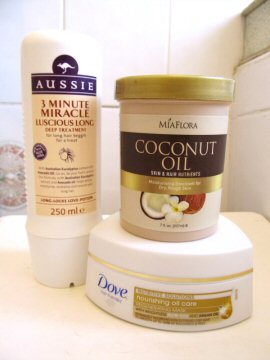 Hair health maintenance is about a lot more than shampoo and conditioner! In
order to grow long healthy hair, the ends need to be very well cared for. As
well as your usual cleansing routine, incorporate a once a week deep
conditioning treatment. It will make a huge difference and most definitely
contribute to the overall health of your tresses. There are a wide variety of
deep conditioners on the market, which one you use is all a matter of personal
preference. Leave in conditioners come in several forms – creams, sprays and
oils. If you have fine hair, experiment with the liquid spray kind – these are
nourishing without leaving too much residue. If your hair is thick, creams and
oils may be your best bet. These products are designed to be left in the hair
after washing, and are mostly applied at the ends and mid lengths of the hair –
not the scalp. They provide further conditioning after your regular routine,
sealing in the moisture from water and other products. Many people prefer to
make their own leave in treatments with oils, the most popular being coconut or
olive oil. Of all the oils used in hair care, these two are the only ones that
have been proven to actually penetrate the hair shaft and give intense
nourishment. Coconut oil is not as heavy as olive, and is what I personally use.
It can be used as a deep conditioner, a pre-shampoo treatment or a leave in
treatment. Try to use an oil that is fragrance free and 100% pure. If you want
to experiment with olive oil, ensure you use only the extra virgin kind. I have
included a photograph of some examples of deep conditioning treatments. Hair health maintenance is about a lot more than shampoo and conditioner! In
order to grow long healthy hair, the ends need to be very well cared for. As
well as your usual cleansing routine, incorporate a once a week deep
conditioning treatment. It will make a huge difference and most definitely
contribute to the overall health of your tresses. There are a wide variety of
deep conditioners on the market, which one you use is all a matter of personal
preference. Leave in conditioners come in several forms – creams, sprays and
oils. If you have fine hair, experiment with the liquid spray kind – these are
nourishing without leaving too much residue. If your hair is thick, creams and
oils may be your best bet. These products are designed to be left in the hair
after washing, and are mostly applied at the ends and mid lengths of the hair –
not the scalp. They provide further conditioning after your regular routine,
sealing in the moisture from water and other products. Many people prefer to
make their own leave in treatments with oils, the most popular being coconut or
olive oil. Of all the oils used in hair care, these two are the only ones that
have been proven to actually penetrate the hair shaft and give intense
nourishment. Coconut oil is not as heavy as olive, and is what I personally use.
It can be used as a deep conditioner, a pre-shampoo treatment or a leave in
treatment. Try to use an oil that is fragrance free and 100% pure. If you want
to experiment with olive oil, ensure you use only the extra virgin kind. I have
included a photograph of some examples of deep conditioning treatments.
Step 6: Consider Up-Dos
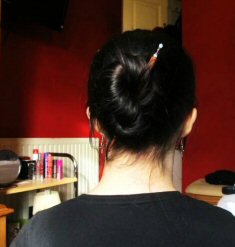 Wearing your hair down invites opportunities for breakage. This can occur
from brushing after it has tangled or friction from other objects, such as car
seats or clothes. The most efficient way of protecting your hair as far as
up-dos go is with buns using hair sticks. This is totally damage free, and will
ensure that any length you have gained is retained. A quick internet search of
'hair stick up-dos' will provide you with hundreds of techniques. I have attached
a photograph of my hair in a 'figure 8 bun' using 1 wooden hair stick. This is a
very easily style that can be easily achieved with minimal practice. Wearing your hair down invites opportunities for breakage. This can occur
from brushing after it has tangled or friction from other objects, such as car
seats or clothes. The most efficient way of protecting your hair as far as
up-dos go is with buns using hair sticks. This is totally damage free, and will
ensure that any length you have gained is retained. A quick internet search of
'hair stick up-dos' will provide you with hundreds of techniques. I have attached
a photograph of my hair in a 'figure 8 bun' using 1 wooden hair stick. This is a
very easily style that can be easily achieved with minimal practice.
Conclusion:
Now you have read all this information, it is time to put it into
practice! By following the guide above you are sure to have the healthiest hair
possible, while also promoting hair growth and length retention.
Side note:
All
of the products shown on this article have been purchased by the author. I am in
no way affiliated with any of the brands shown.
Hair
The Ultimate Guide to Growing Long Healthy Hair
Importance of Personal Presentation and Hygiene in a Salon
How to Consult a Client Before a Hair Treatment
Natural Homemade Remedies for Frizzy Hair
|